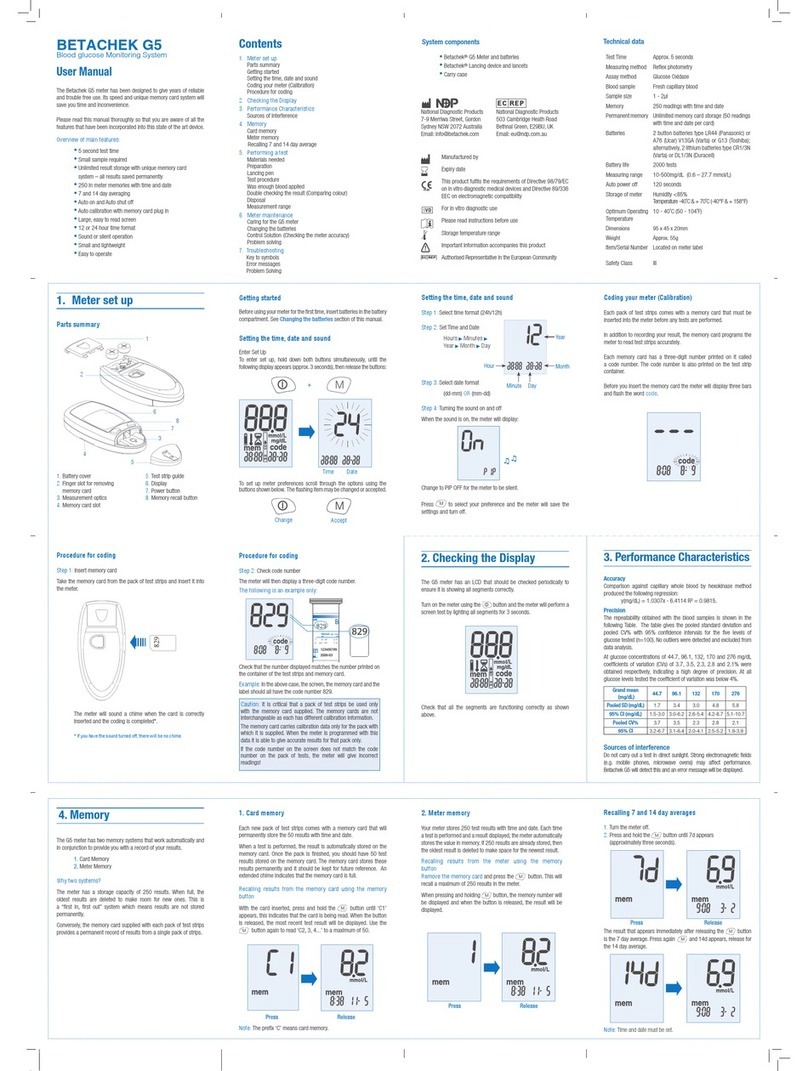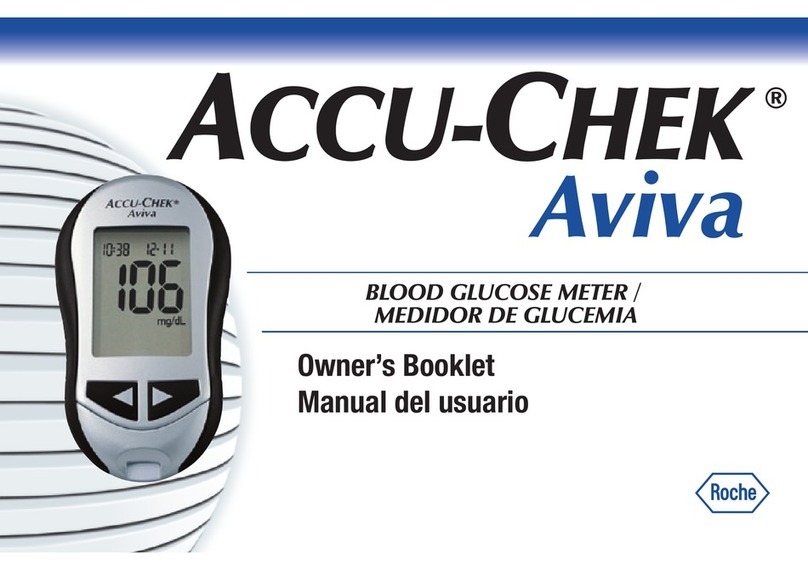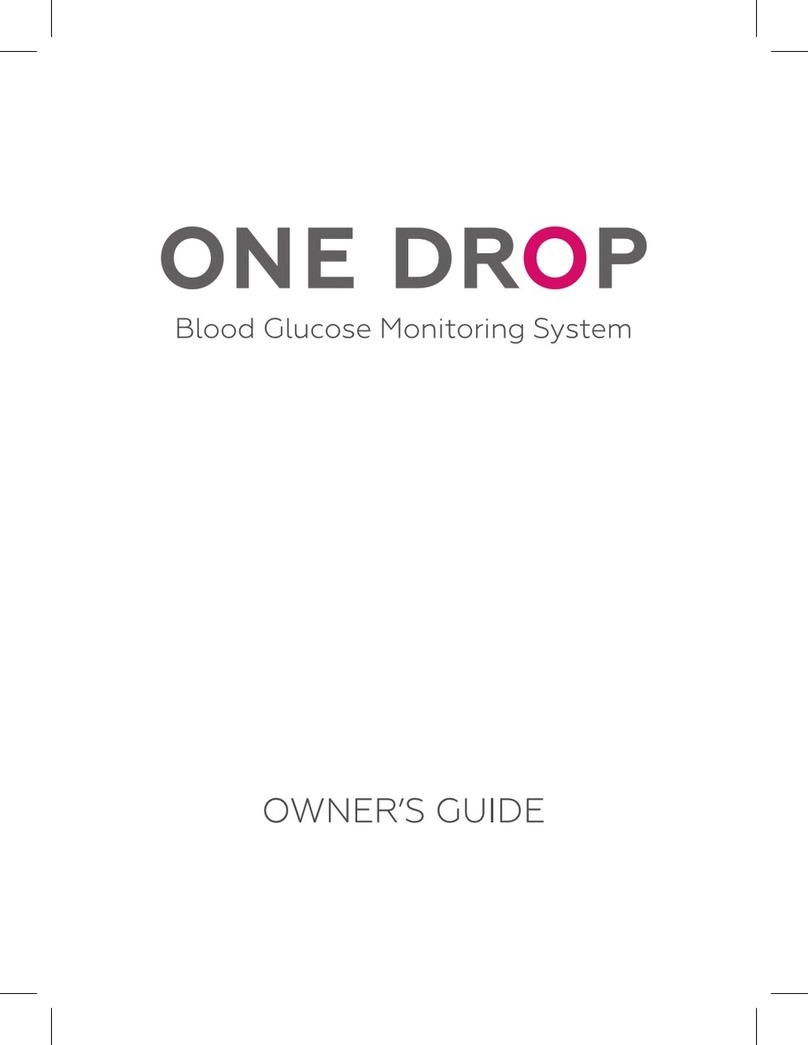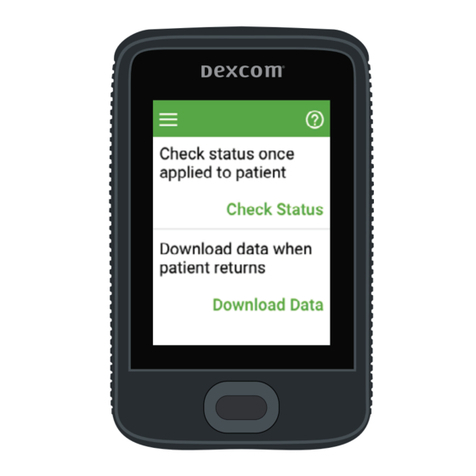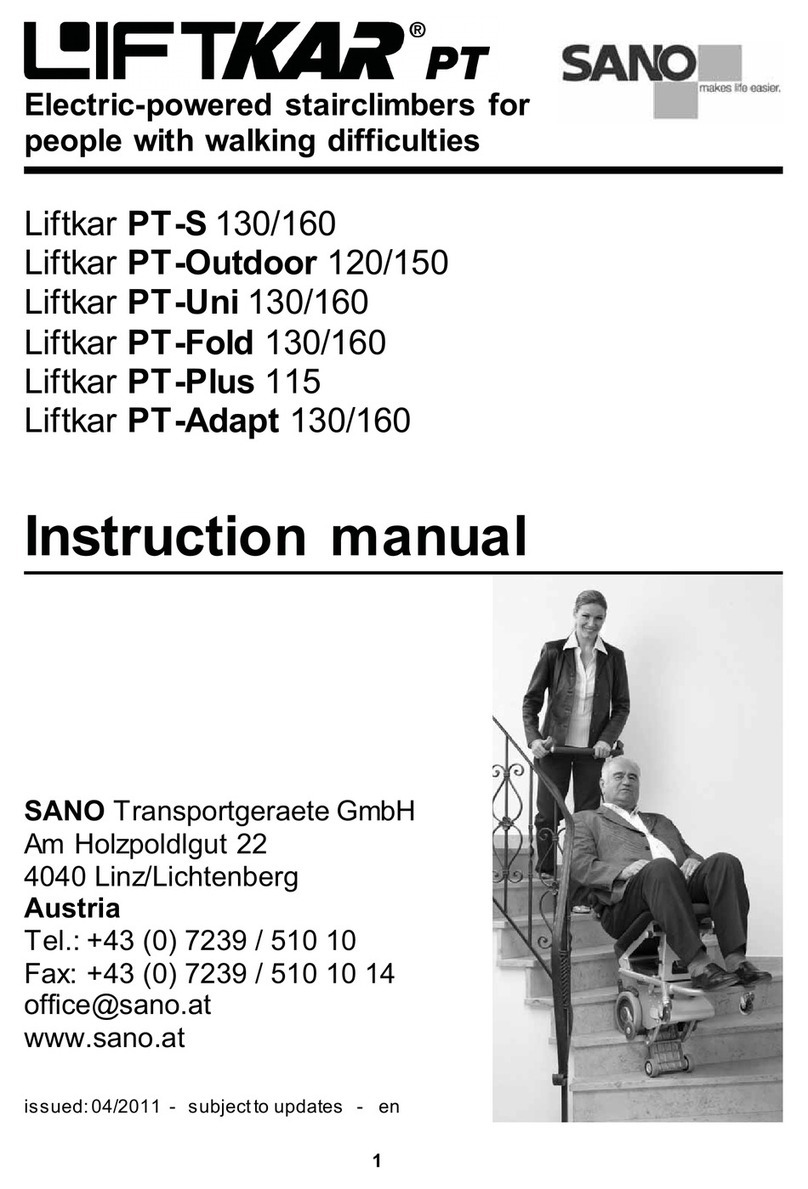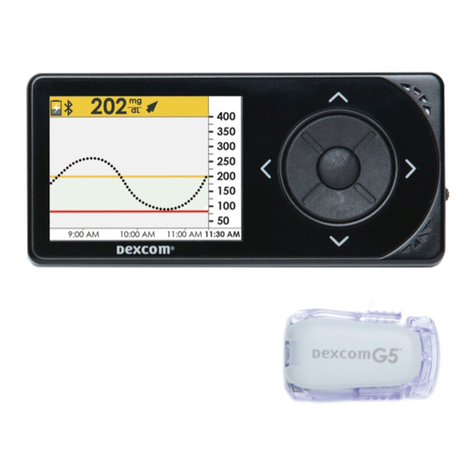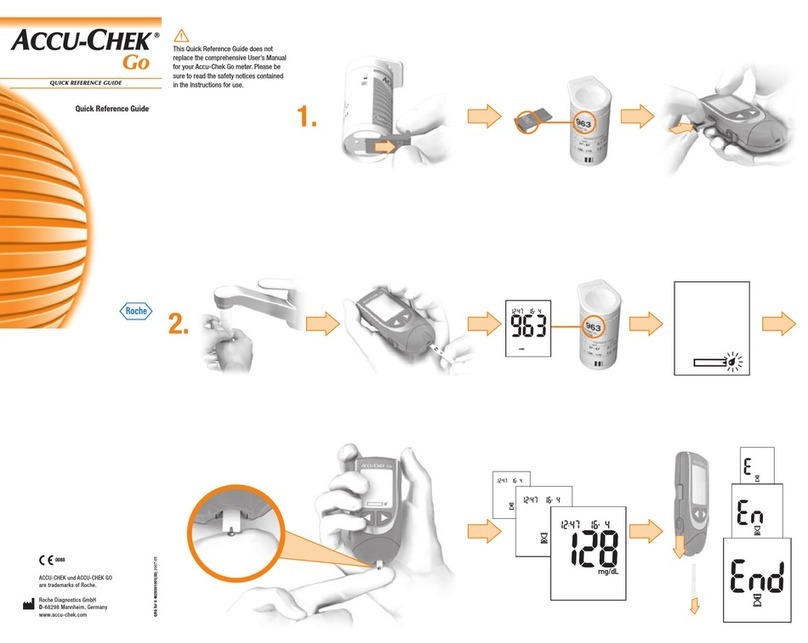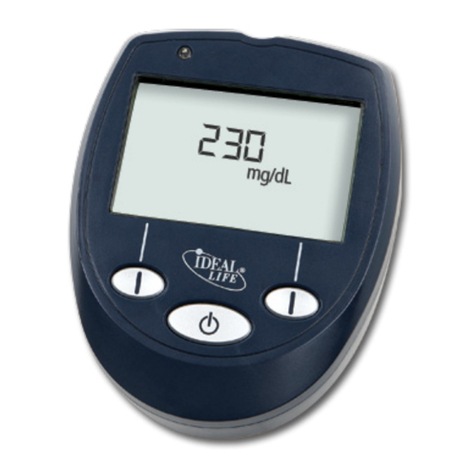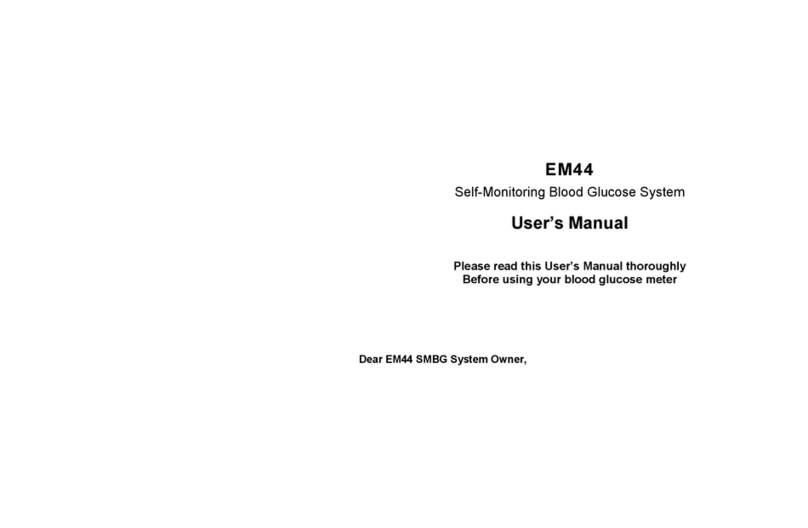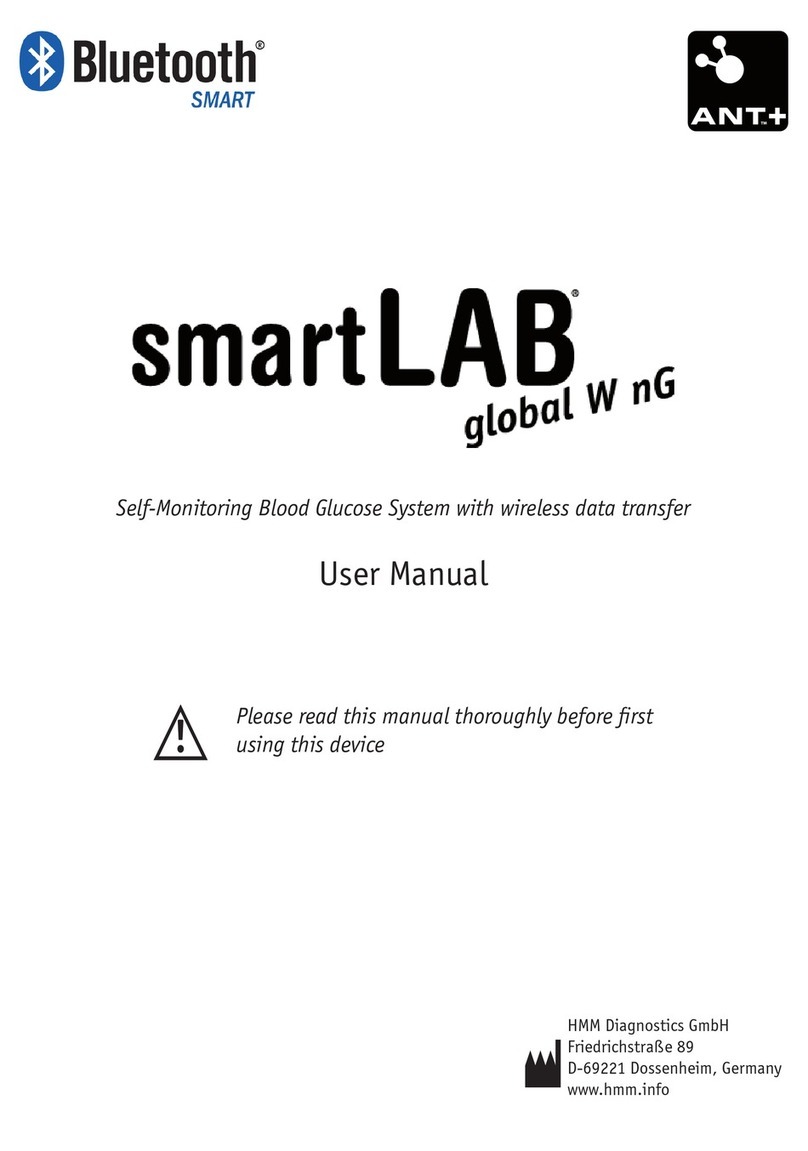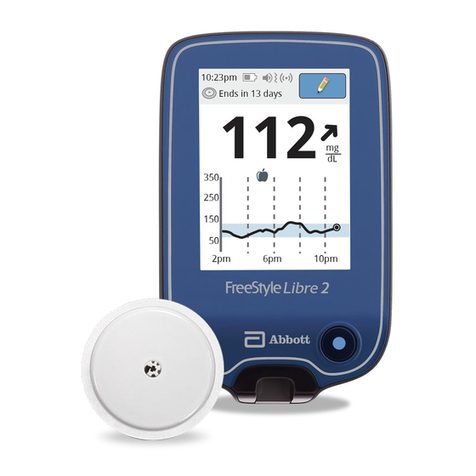BETACHEK C50 User manual

Blood glucose test cassette instructions
Open the sensor cover and clean the sensor without a
cassette inserted. See Video: Cleaning the Betachek C50
blood glucose meter
The Betachek C50 test cassette with the Betachek C50
meter are intended to quantitatively measure glucose in
fresh capillary whole blood. The system is intended for in
vitro diagnostic self testing of blood glucose, as an aid in
monitoring the effectiveness of diabetes control.
Self-testing helps both you and your doctor check your blood
glucose management, however self-testing should not be
seen as a substitute for regular visits to your doctor. Please
remember that testing should only be undertaken after
you have received a thorough course of instruction from a
qualified health care professional. You should only adapt your
treatment if you have been trained to do so.
Container with 1 or 2 test cassette(s), 1 package insert.
• Store unopened cassettes in their original container in
a cool, dry place at 2-30°C (35-86°F). Do not freeze.
If stored in a refrigerator, remove and warm to room
temperature before opening the container.
• Testing should be performed between 10-40°C (50-
104°F)
• Do not use test cassettes past the expiration date. Test
cassettes must be used within three months (90 days) of
opening.
• Use the test cassette immediately after it is removed from
the container.
• Do not use a test cassette from a container that has been
damaged.
• All items in the pack may be discarded with your regular
household waste.
The meter requires at least 0.3μL of blood. The test can take
as little time as 5 seconds (time varies with blood glucose
concentration).
To ensure that your meter and cassette are functioning
properly and that you are carrying out the test correctly, you
must regularly check the performance of the system with
Betachek control solution. See your meter user manual or
control solution instructions for further details.
• For in vitro diagnostic use only.
• Test cassettes are for personal use only. They are not
suitable for doctor’s offices or other health care facilities.
• Do not carry out the test in direct sunlight.
• Not for neonatal use.
• Use fresh capillary blood only. Do not use plasma, venous
blood or serum.
• Abnormally low hematocrit (<35%) may produce falsely
high readings and abnormally high hematocrit (>55%)
may produce falsely low readings.
• Strong electromagnetic fields (e.g. large magnets,
microwave ovens) may affect performance. Move away
from electromagnetic fields before testing.
• Maltose and Xylose do not affect results.
• Test results may be falsely low if the patient is severely
dehydrated, in shock, or in a hyperosmolar state (with or
without ketosis).
• Critically ill patients should not be tested with blood
glucose meters.
• Lipemic samples: Cholesterol levels up to 700 mg/
dl (18.1mmol/l) and triglycerides up to 5000 mg/dl
(57.1mmol/l) do not affect the results.
Betachek C50 test zones contain: FAD GDH 0.12%,
chromagen 0.31%, stabiliser 1.2%, inert ingredients
98.28%. The cassette contains a silica based drying agent.
The Betachek C50 system is linear and displays results
between 20 and 600mg/dL or 1.1 and 33.3 mmol/L. The
units of measure are factory set and cannot be changed.
The system is calibrated with whole blood samples adjusted
to a range of glucose concentrations. A YSI (Yellow Springs
Instruments) 2300 analyser is used to measure the glucose
concentrations in the samples. This instrument is traceable to
an NIST standard. Control solution results obtained with the
cassettes are therefore also traceable to an NIST standard.
Results are expressed as plasma equivalents.
The Betachek C50 blood glucose monitoring system complies
with the requirements of EN ISO 15197:2013.
Within ±5mg/dL
(Within ±
0.28 mmol/L)
Within ±10mg/dL
(Within ±
0.56 mmol/L)
Within ±15mg/dL
(Within ±
0.83 mmol/L)
124/198
(62.6%) 189/198
(95.4%) 194/198
(97.9%)
System accuracy results for glucose concentrations
<5.55mmol/L (<100mg/dL)
Within ±5% Within ±10% Within ±15%
267/402
(66%) 366/402
(91%) 400/402
(99.5%)
System accuracy results for glucose concentrations
≥5.55mmol/L (≥100mg/dL)
Within ±15mg/L (±0.83mmol/L) and within ±15%
594/600 (99%)
System accuracy results for glucose concentration
between 37.9mg/dL (2.1mmol/L) and
458.8mg/dL (25.48mmol/L)
System accuracy:
Repeatability:
Mean value
mg/dL 40 92 146 221 288
mmol/L 2.2 5.1 8.1 12.3 16
Standard deviation
mmol/L 0.1 0.12 0.12 0.2 0.3
Coefficient of variation
% - - 1.4 1.7 1.9
Precision:
Mean value
mg/dL 50.4 108 288
mmol/L 2.8 6 16
Standard deviation
mmol/L 0.14 0.16 0.3
Coefficient of variation
% 4.7 2.6 1.7
Performance assessment by the user:
A study evaluating glucose values from fingertip capillary
blood samples obtained by 100 laypersons showed the
following results:
• For glucose concentrations less than 5.55mmol/L (100mg/
dL), 100% of test results were within ±0.83mmol/L
(±15mg/dL) of the results obtained by laboratory testing.
• For glucose concentrations equal to or greater than
5.55mmol/L (100mg/dL), 100% of test results were within
±15% of the results obtained by laboratory testing.
Email: [email protected]
Explanation of symbols:
The meaning of symbols used in the packaging is as follows:
Consult the package insert
Store at (temperature limitation)
Use by/Expiry date unopened
Use cassette within 90 days of opening the
container
Test cassettes can be disposed of in household
waste
Manufacturer
Catalogue number
Lot number
For in vitro diagnostic use
This product fulfills the requirements of the
European Directive 98/79/EC on in vitro
diagnostic medical devices.
Authorised representative in the European
Community
Betachek GmbH
Am Dorbach 12
Aachen 52076
Germany
Email: [email protected]
National Diagnostic Products Pty Ltd
7-9 Merriwa Street
Gordon NSW 2072
Australia
www.betachek.com
©2022 National Diagnostic Products
Date issued: 2022-02
Version: EN/DE Revision: 9
See Betachek C50 user manual for instructions. (User manual
and instructional videos are also available online.)
The normal fasting glucose level for a non diabetic adult
is below 100mg/dL (5.6mmol/L). Consult your healthcare
professional for the glucose range that is appropriate for
you. If your test result is lower than 20mg/dL (1.1mmol/L), a
‘Lo’ message will appear indicating a low glucose level. This
may indicate severe hypoglycemia (low blood glucose). You
should treat this immediately and repeat the test. If the result
is higher than 600mg/dL (33.3mmol/L) a ‘Hi’ message will
be displayed. This may indicate severe hyperglycemia. You
should repeat the test and if the ‘Hi’ message appears again
you should contact your healthcare professional.
The test employs FAD GDH and a chromagen along with
nonreactive ingredients to produce a colour change that is
directly proportional to the amount of D-glucose in the blood
sample. The meter measures this change and converts it to a
blood glucose result.
BETACHEK is a trademark of National Diagnostic Products.
0123
www.betachekC50.co.uk/videos
Before inserting a new cassette:
Intended use
Contents of the pack
Storage and handling
Performing a test
Test results
Blood volume and test time
Checking the system
Limitations of the test
Test principle
Interfering substances
Chemical composition
Measurement range
Calibration
Performance characteristics of the Betachek C50
system
Performance characteristics according to EN ISO
15197:2013
Customer support
EC REP
EC REP
90D
0123
These instructions are to be read in conjunction with the
BETACHEK C50 meter instruction manual.
General
Never share your meter, a lancet or the lancing device with
anyone. Always wash the puncture site with soap and water
before testing. Dry thoroughly.
Infection control
EN

Blutzuckertestkassette Gebrauchsanleitung
Öffnen Sie die Sensorabdeckung und reinigen Sie den
Sensor ohne eingelegte Kassette. Siehe Video; Betachek
C50 - Messgerät reinigen.
Die BETACHEK C50 Testkassette mit dem BETACHEK C50
Messgerät dient zur quantitativen Messung von Glukose in
frischem kapillaren Vollblut. Das System ist für den in-vitro-
diagnostischen Selbsttest von Blutzucker vorgesehen, um die
Wirksamkeit der Diabetes-Kontrolle zu überwachen.
Selbsttests helfen Ihnen und Ihrem Arzt, Ihr
Blutzuckermanagement zu überprüfen. Selbsttests sollten
jedoch nicht als Ersatz für regelmäßige Besuche bei Ihrem
Arzt angesehen werden. Bitte beachten Sie, dass Tests nur
durchgeführt werden sollten, nachdem Sie eine gründliche
Einweisung von einem qualifizierten medizinischen
Fachpersonal erhalten haben. Sie sollten Ihre Behandlung nur
anpassen, wenn Sie dazu geschult wurden.
Behälter mit 1 oder 2 Testkassette(n), 1 Packungsbeilage.
• Lagern Sie ungeöffnete Kassetten im Originalbehälter an
einem kühlen, trockenen Ort bei 2-30°C (35-86°F). Nicht
einfrieren. Bei Kühlschranklagerung Behälter vor dem
Öffnen auf Raumtemperatur erwärmen.
• Tests sollten zwischen 10-40°C (50-104°F) durchgeführt
werden.
• Verwenden Sie keineTestkassetten nach demVerfallsdatum.
Testkassetten müssen innerhalb von drei Monaten (90
Tagen) nach dem Öffnen verwendet werden.
• Verwenden Sie die Testkassette sofort nach Entnahme aus
dem Behälter.
• Verwenden Sie keine Testkassette aus einem beschädigten
Behälter.
• Alle Artikel in der Packung können mit dem normalen
Hausmüll entsorgt werden.
Das Messgerät benötigt mindestens 0,3 μl Blut. Der Test
dauert bestenfalls nur 5 Sekunden (Zeit variiert je nach
Blutzuckerkonzentration).
Um sicherzustellen, dass Ihr Messgerät und Ihre Kassette
ordnungsgemäß funktionieren und Sie den Test korrekt
durchführen, müssen Sie regelmäßig die Leistung des
Systems mit BETACHEK Kontrolllösung überprüfen. Weitere
Informationen finden Sie in der Bedienungsanleitung Ihres
Messgeräts oder in den Anleitungen zur Kontrolllösung.
• Nur für die In-vitro-Diagnostik.
• Testkassetten sind nur für den persönlichen Gebrauch
bestimmt. Sie sind nicht für Arztpraxen oder andere
Gesundheitseinrichtungen geeignet.
• Führen Sie den Test nicht unter direkter Sonneneinstrahlung
durch.
• Nicht für Neugeborene geeignet.
• Verwenden Sie nur frisches Kapillarblut. Verwenden Sie
kein Plasma, venöses Blut oder Serum.
• Ein ungewöhnlich niedriger Hämatokrit (<35%) kann zu
falsch hohen Messwerten führen, und ein ungewöhnlich
hoher Hämatokrit (>55%) kann zu falsch niedrigen
Messwerten führen.
• Starke elektromagnetische Felder (z. B. große Magnete,
Mikrowellenherde) können die Leistung beeinträchtigen.
Entfernen Sie sich vor dem Testen von elektromagnetischen
Feldern.
• Maltose und Xylose beeinflussen die Ergebnisse nicht.
• Die Testergebnisse können falsch niedrig sein, wenn der
Patient stark dehydriert ist, unter Schock steht oder sich
in einem hyperosmolaren Zustand (mit oder ohne Ketose)
befindet.
• Schwerkranke Patienten sollten nicht mit
Blutzuckermessgeräten getestet werden.
• Lipämische Proben: Cholesterinwerte von bis zu 700 mg/dl
(18,1 mmol/l) und Triglyceride von bis zu 5000 mg/dl (57,1
mmol/l) beeinflussen die Ergebnisse nicht.
BETACHEK C50 Testzonen enthalten: FAD GDH 0,12%,
Chromagen 0,31%, Stabilisator 1,2%, inerte Inhaltsstoffe
98,28%. Die Kassette enthält ein Trocknungsmittel auf
Kieselsäurebasis.
Das BETACHEK C50 System ist linear und zeigt Ergebnisse
zwischen 20 und 600 mg/dl oder 1,1 und 33,3 mmol/l an.Die
Maßeinheiten sind werkseitig eingestellt und können nicht
geändert werden.
Das System ist mit Vollblutproben kalibriert, die auf eine Reihe
von Glukosekonzentrationen abgestimmt sind. Ein YSI (Yellow
Springs Instruments) 2300 Analysator wird verwendet, um die
Blutzuckerkonzentrationen in den Proben zu messen. Dieses
Gerät ist auf einen NIST-Standard rückführbar. Die mit den
Kassetten erzielten Kontrolllösungsergebnisse sind daher
auch auf einen NIST-Standard rückführbar. Die Ergebnisse
werden als Plasmaäquivalente ausgedrückt.
Das BETACHEK C50 Blutzuckermesssystem erfüllt die
Anforderungen der EN ISO 15197: 2013.
Innerhalb von
± 5 mg/dl
(± 0.28 mmol/l)
Innerhalb von
± 10 mg/dl
(± 0.56 mmol/l)
Innerhalb von
± 15 mg/dl
(± 0.83 mmol/l)
124/198
(62,6%) 189/198
(95,4%) 194/198
(97,9%)
Systemgenauigkeitsergebnisse für Blutzuckerkonzentrationen
<5,55 mmol/l (<100 mg/dl)
Innerhalb von
±5%
Innerhalb von
±10%
Innerhalb von
±15%
267/402
(66%) 366/402
(91%) 400/402
(99.5%)
Systemgenauigkeitsergebnisse für Blutzuckerkonzentrationen
≥5,55 mmol/l (≥100 mg/dl)
Innerhalb von ± 15 mg/l (± 0,83 mmol/l) und
Innerhalb von ±15%
594/600 (99%)
Systemgenauigkeitsergebnisse für Blutzuckerkonzentrationen
zwischen 37,9 mg/dl (2,1 mmol/l) und 458,8 mg/dl (25,48
mmol/l)
Systemgenauigkeit:
Wiederholbarkeit:
Mittelwert
mg/dl 40 92 146 221 288
mmol/l 2,2 5,1 8,1 12,3 16
Standardabweichung
mmol/l 0.1 0.12 0.12 0.2 0.3
Variationskoefzient
% - - 1,4 1,7 1,9
Präzision:
Mittelwert
mg/dl 50,4 108 288
mmol/l 2,8 6 16
Standardabweichung
mmol/l 0,14 0,16 0,3
Variationskoeffizient
% 4,7 2,6 1,7
Leistungsbeurteilung durch den Anwender:
Eine Studie zur Auswertung von Blutzuckerwerten aus
Fingerspitzen-Kapillarblutproben von 100 Laien zeigte
folgende Ergebnisse:
• Bei Blutzuckerkonzentrationen unter 5,55 mmol/l (100
mg/dl) lagen 100% der Testergebnisse innerhalb von ±
0,83 mmol/l (± 15 mg/dl) der durch Labortests erzielten
Ergebnisse.
• Bei Blutzuckerkonzentrationen gleich oder größer als
5,55 mmol/l (100 mg/dl) lagen 100% der Testergebnisse
innerhalb von ± 15% der durch Labortests erzielten
Ergebnisse.
Erläuterung der Symbole:
Die in der Verpackung verwendeten Symbole haben folgende
Bedeutung:
Gebrauchsanweisung beachten
Temperaturbereich bei Lagerung
Verwendbar bis / Verfallsdatum - ungeöffnet
Verwenden Sie die Kassette innerhalb von 90
Tagen nach dem Öffnen des Behälters
Testkassetten können im Hausmüll entsorgt
werden.
Hersteller
Bestellnummer
Chargenbezeichnung
In-vitro-Diagnostika
Dieses Produkt erfüllt die Anforderungen der
europäischen Richtlinie 98/79 / EG für In-vitro-
Diagnostika.
Bevollmächtigter in der Europäischen
Gemeinschaft
Betachek GmbH
Am Dorbach 12, 52076 Aachen
Deutschland
National Diagnostic Products Pty Ltd
7-9 Merriwa Street
Gordon NSW 2072
Sydney Australien
www.betachek.com
©2022 National Diagnostic Products
Date issued: 2022-02
Version: BC50-EN/DE Revision: 9
Anweisungen finden Sie im BETACHEK C50 Benutzerhandbuch.
(Benutzerhandbuch und Anleitungsvideos sind auch online
verfügbar.)
Der normale Nüchternblutzuckerspiegel für einen
Erwachsenen ohne Diabetes liegt unter 100 mg/dl (5,6
mmol/l). Fragen Sie Ihren Arzt nach dem für Sie geeigneten
Blutzuckerbereich. Wenn Ihr Testergebnis unter 20 mg/
dl (1,1 mmol/l) liegt, erscheint eine „Lo“-Meldung, die auf
einen niedrigen Blutzuckerspiegel hinweist. Dies kann auf
eine schwere Hypoglykämie (niedriger Blutzucker) hinweisen.
Sie sollten dies sofort behandeln und den Test wiederholen.
Wenn das Ergebnis über 600 mg/dl (33,3 mmol/l) liegt, wird
die Meldung “Hi” angezeigt. Dies kann auf eine schwere
Hyperglykämie hinweisen.Sie sollten den Test wiederholen.
Wenn die Meldung “Hi” erneut angezeigt wird, wenden Sie
sich an Ihren Arzt.
Teilen Sie Ihr Messgerät, eine Lanzette oder die Stechhilfe
niemals mit anderen Personen. Waschen Sie die Einstichstelle
vor dem Testen immer mit Wasser .und Seife. Hände gründlich
abtrocknen
Der Test verwendet FAD GDH und ein Chromagen zusammen
mit nicht reaktiven Inhaltsstoffen, um eine Farbänderung zu
erzeugen, die direkt proportional zur Menge an D-Glucose in
der Blutprobe ist. Das Messgerät misst diese Veränderung und
wandelt sie in ein Blutzuckerergebnis um.
BETACHEK®ist eine Marke von National Diagnostic Products.
0123
+49 (0)241 / 91998866
Vor dem Einlegen einer neuen Kassette:
Verwendungszweck
Allgemeines
Inhalt der Packung
Lagerung und Handhabung
Durchführung eines Tests
Testergebnisse
Blutvolumen und Testzeit
Überprüfung des Systems
Einschränkungen des Tests
Infektionsschutz
Testprinzip
Störende Substanzen
Chemische Zusammensetzung
Messbereich
Kalibrierung
Leistungsmerkmale des BETACHEK C50 Systems
Leistungsmerkmale nach EN ISO 15197: 2013
Kundensupport
EC REP
EC REP
90D
0123
Diese Anleitung ist in Verbindung mit dem Benutzerhandbuch
des BETACHEK C50 Messgeräts zu lesen.
www.betachek.de/videos
DE
Other manuals for C50
2
Table of contents
Languages:
Other BETACHEK Blood Glucose Meter manuals
Popular Blood Glucose Meter manuals by other brands
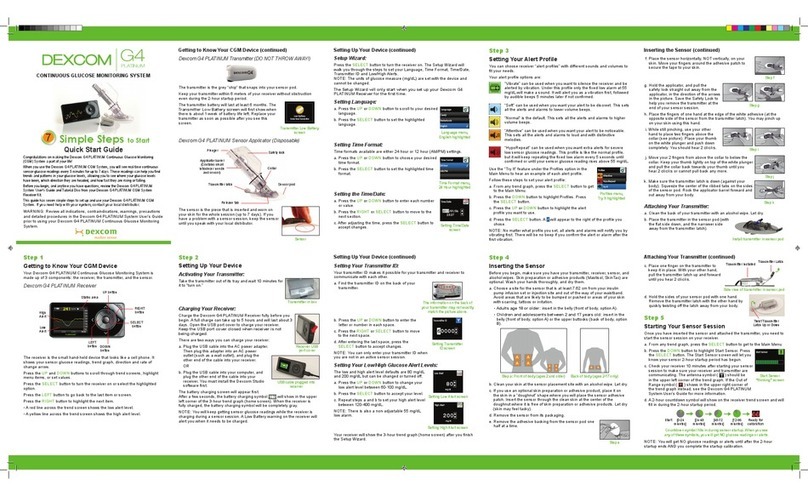
Dexcom
Dexcom G4 Platinum quick start guide
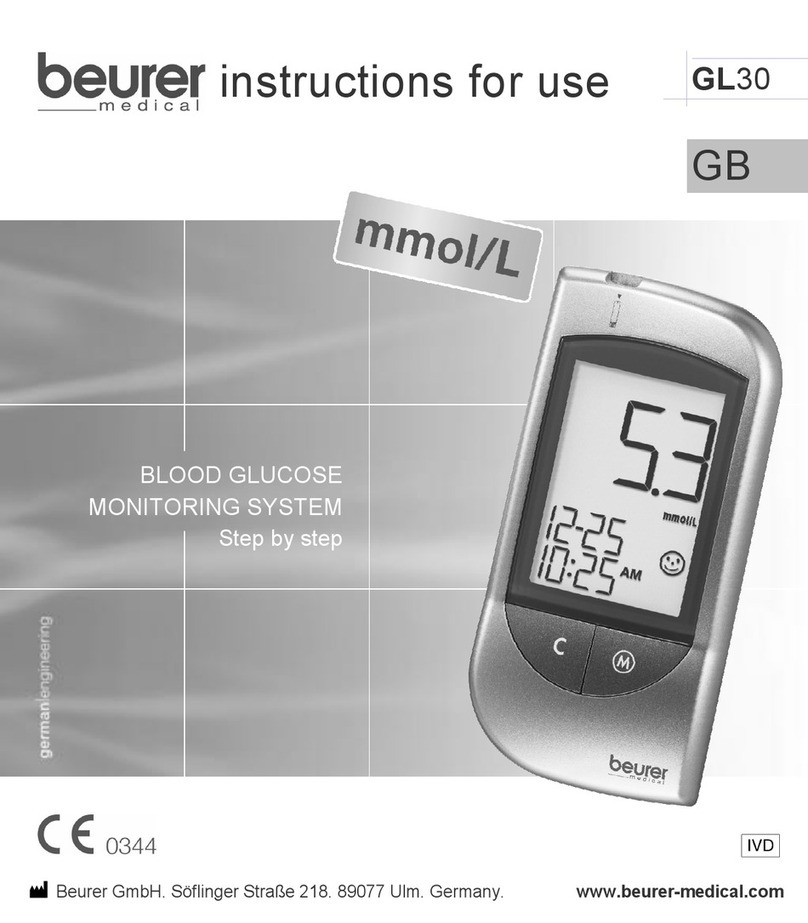
Beurer medical
Beurer medical GL30 Instructions for use
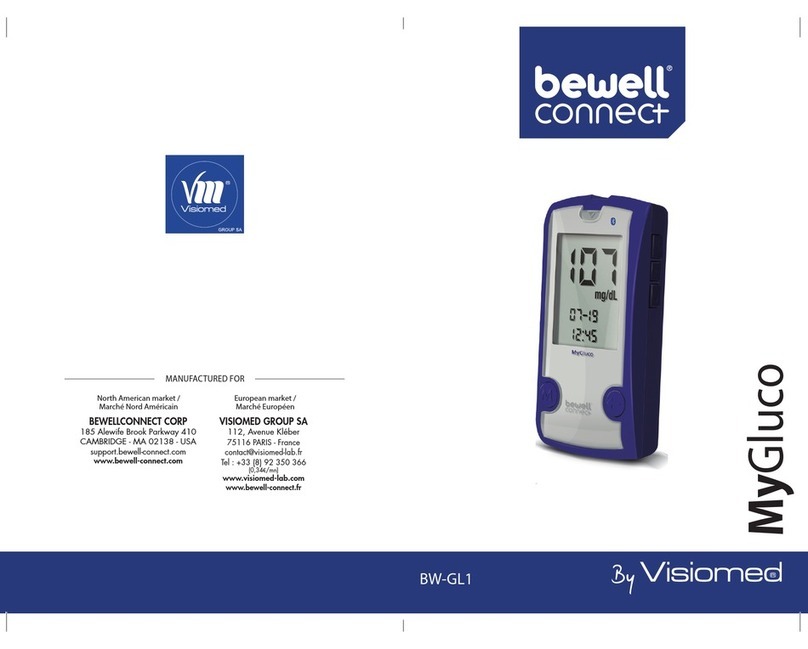
bewell connect
bewell connect MyGluco BW-GL1 manual

Roche
Roche ACCU-CHEK Inform II Operator's manual
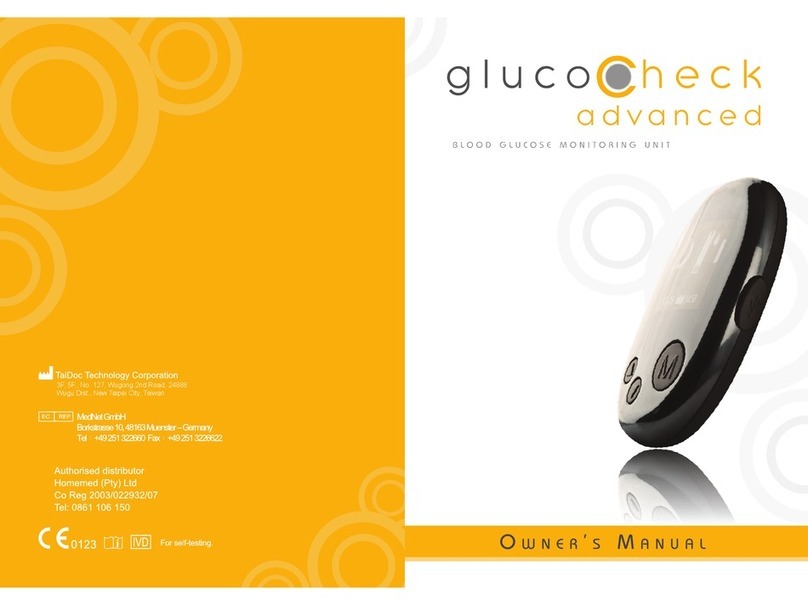
Homemed
Homemed GlucoCheck Advanced owner's manual

NIPRO Diagnostics
NIPRO Diagnostics TrueResult Twist owner's manual
